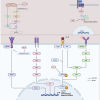Mechanisms of Action of HSP110 and Its Cognate Family Members in Carcinogenesis
- PMID: 39553399
- PMCID: PMC11568853
- DOI: 10.2147/OTT.S496403
Mechanisms of Action of HSP110 and Its Cognate Family Members in Carcinogenesis
Abstract
Tumors, as chronic malignant diseases that account for about 20% of all deaths worldwide, are the number one threat to human health. Until now there is no reliable treatment for most types of tumors. Tumorigenesis and cellular carcinogenesis remain difficult challenges due to their complex etiology and unknown mechanisms. As stress process regulating molecules and protein folding promoters, heat shock proteins (HSPs) play an important role in cancer development. Most studies have shown that HSPs are one of the major anticancer drug targets. HSPs are not only modulators of the cellular stress response, but are also closely associated with tumor initiation, progression, and drug resistance, so understanding the mechanism of the HSP family involved in cellular carcinogenesis is an important part of understanding tumorigenesis and enabling anticancer drug development. In this review, we discuss the functions and mechanisms of key members of the HSP family (HSP70, HSP90, and HSP110) in participating in the process of tumorigenesis and cell carcinogenesis, and look forward to the prospect of key members of the HSP family in targeted cancer therapy.
Keywords: HSP110; HSP70; HSP90; cancer; mechanisms.
© 2024 Guo et al.
Conflict of interest statement
The authors declare that the research was conducted in the absence of any commercial or financial relationships that could be construed as a potential conflict of interest.
Figures
Similar articles
-
Targeting heat shock protein 90 for anti-cancer drug development.Adv Cancer Res. 2021;152:179-204. doi: 10.1016/bs.acr.2021.03.006. Epub 2021 Apr 20. Adv Cancer Res. 2021. PMID: 34353437
-
Heat Shock Proteins, a Double-Edged Sword: Significance in Cancer Progression, Chemotherapy Resistance and Novel Therapeutic Perspectives.Cancers (Basel). 2024 Apr 14;16(8):1500. doi: 10.3390/cancers16081500. Cancers (Basel). 2024. PMID: 38672583 Free PMC article. Review.
-
The hsp110 and Grp1 70 stress proteins: newly recognized relatives of the Hsp70s.Cell Stress Chaperones. 2000 Oct;5(4):276-90. doi: 10.1379/1466-1268(2000)005<0276:thagsp>2.0.co;2. Cell Stress Chaperones. 2000. PMID: 11048651 Free PMC article. Review.
-
Comprehensive Pan-Cancer Analysis of Heat Shock Protein 110, 90, 70, and 60 Families.Front Mol Biosci. 2021 Oct 12;8:726244. doi: 10.3389/fmolb.2021.726244. eCollection 2021. Front Mol Biosci. 2021. PMID: 34712697 Free PMC article.
-
Heat shock proteins: Biological functions, pathological roles, and therapeutic opportunities.MedComm (2020). 2022 Aug 2;3(3):e161. doi: 10.1002/mco2.161. eCollection 2022 Sep. MedComm (2020). 2022. PMID: 35928554 Free PMC article. Review.
References
Publication types
LinkOut - more resources
Full Text Sources
Research Materials
Miscellaneous


